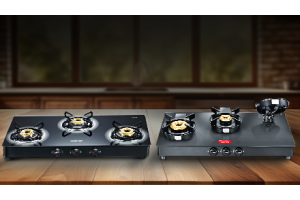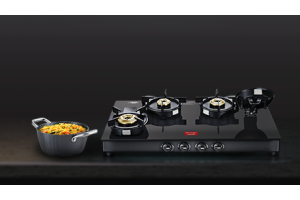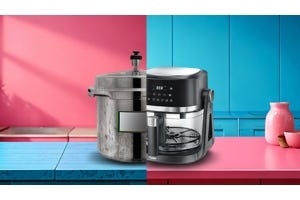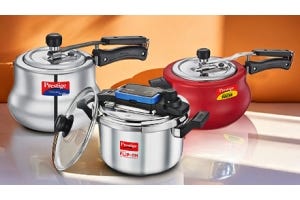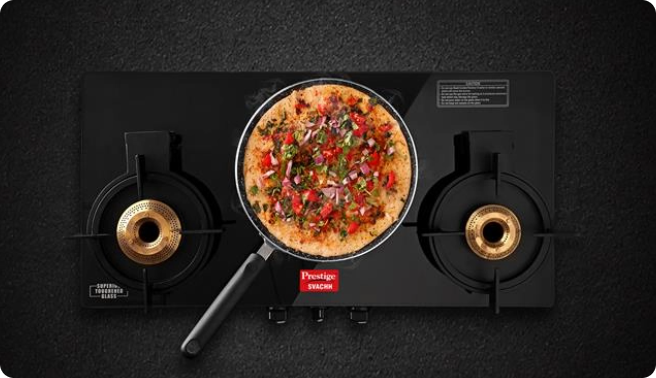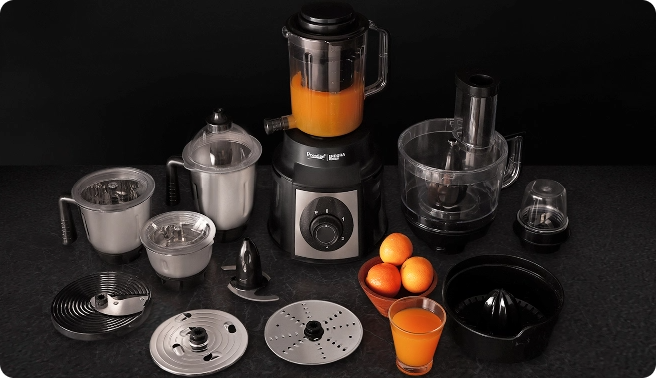Introduction
Pressure cooker is a must-have for vegetarian cooking, facilitating the preparation of nourishing, filling meals in little time. From soothing dals and stews to tender beans and grains cooked to perfection, it makes cooking simple while enriching flavors. Whether you're a novice in plant-based cooking or an expert, a pressure cooker will revolutionize your kitchen experience.
Top Benefits of Cooking with a Pressure Cooker
1. Preserves More Nutrients
Pressure cooking preserves vital vitamins and minerals in vegetables more effectively than regular boiling, providing healthier, nutrient-rich meals.
2. Cooks Quicker & Saves Time
It significantly shortens cooking time for legumes, grains, and root vegetables, making meal preparation quick and easy—ideal for busy days!
3. Brings Out Flavors Naturally
The high-pressure atmosphere enhances flavors, providing vegetarian foods with a deep, fulfilling flavor without the use of large amounts of oils or spices.
Are Pressure Cooker Recipes Healthy?
Cooking with an Instant Pot or pressure cooker is a fantastic way to prepare nutritious meals efficiently. The shorter cooking time helps retain more vitamins and minerals compared to longer cooking methods, making it an excellent choice for those seeking both convenience and nutrition. Additionally, this method enhances the taste and texture of food, allowing busy individuals to enjoy wholesome, flavorful meals without compromising on health or time.
Here are some healthy pressure cooker recipes to make nutritious meals effortlessly—because great food shouldn't take forever!
1) Pressure Cooker Chocolate Chip Cheesecake
Ingredients:
-
1 cup graham cracker crumbs
-
2 tbsp brown sugar
-
¼ tsp salt
-
3 tbsp melted butter
-
16 oz (2 blocks) cream cheese, softened
-
½ cup white sugar
-
1 tsp vanilla extract
-
2 eggs, room temperature
-
½ cup mini semisweet chocolate chips
Instructions:
a) Prepare the Crust:
- Mix graham cracker crumbs, brown sugar, and salt in a bowl. Stir in melted butter until combined.
- Press the mixture into the bottom of a greased 6-inch springform pan lined with parchment paper. Freeze while preparing the filling.
b) Make the Filling:
- Beat cream cheese, sugar, and vanilla until smooth. Add eggs one at a time, mixing on low speed. Fold in chocolate chips.
- Pour the filling over the crust and cover the pan with a paper towel and foil.
c) Cook the Cheesecake:
- Place a trivet and 1 cup of water in the prestige svachh popular spillage control ss pressure cooker. Use a foil sling to lower the pan onto the trivet.
- Lock the lid and set to high pressure for 30 minutes. Allow natural pressure release.
- Remove the cheesecake and cool on a wire rack for 10 minutes. Run a knife around the edges, then cool for 1 hour before refrigerating for at least 4 hours.
Serving Tip: Garnish with extra chocolate chips or drizzle with chocolate sauce before serving. Enjoy!
2) Soft & Fluffy Khaman Dhokla in a Pressure Cooker
This instant Khaman Dhokla recipe makes a wonderfully soft, fluffy, and lightly sweet-savory gram flour cake. It’s easy to prepare and can be steamed directly in a pressure cooker without the need for an oven or special steamer.
Ingredients
For the batter:
- 1.5 cups gram flour (besan)
- 1 tablespoon semolina (rava) – optional, for texture
- 1 tablespoon lemon juice (or ¼ teaspoon citric acid)
- 1 teaspoon salt (adjust to taste)
- 1 tablespoon sugar
- 1.5 teaspoons ginger-green chili paste
- 2 to 3 pinches of turmeric powder
- 1 cup water (adjust as needed)
- 1 tablespoon oil
- 2 teaspoons Eno fruit salt (or ½ teaspoon baking soda)
For Tempering:
- 2 tablespoons oil
- 1 teaspoon mustard seeds
- 1 teaspoon sesame seeds (optional)
- 8-10 curry leaves
- 2 green chilies, slit
- ½ cup water
- 1 tablespoon sugar
- 2 teaspoons lemon juice
Garnish:
- Fresh coriander leaves, chopped
- Fresh grated coconut (optional)
Step-by-Step Method
a) Prepare the Pressure Cooker
- Add 2 to 2.5 cups of water to the pressure cooker.
- Place a small stand or an inverted steel bowl inside.
- Remove the whistle (weight) from the lid.
b) Prepare the Batter
- In a mixing bowl, combine gram flour, semolina (if using), turmeric, salt, sugar, ginger-chili paste, lemon juice, and oil.
- Gradually add water while whisking to form a smooth, thick batter. It should flow easily but not be too runny.
- Just before steaming, add Eno fruit salt (or baking soda). Stir briskly in one direction to incorporate air into the batter. You’ll notice it becomes light and frothy.
c) Steam the Dhokla in the Pressure Cooker
- Immediately pour the batter into a greased steel plate or cake tin. Shake lightly to level the batter.
- Place the tin on the stand inside the cooker.
- Cover the lid without the whistle and steam on medium heat for 15 minutes.
- Check doneness by inserting a toothpick; it should come out clean. If needed, steam for 2-3 more minutes.
- Once done, remove and let the dhokla cool slightly before unmolding.
d) Prepare the Tempering
- Heat 2 tablespoons of oil in a small pan.
- Add mustard seeds, let them splutter.
- Add sesame seeds, curry leaves, and green chilies. Sauté for a few seconds.
- Pour in water, sugar, and lemon juice. Let it simmer for a minute.
- Pour this tempering evenly over the dhokla.
e) Garnish & Serve
- Cut the dhokla into squares.
- Garnish with chopped coriander and grated coconut.
- Serve warm with green chutney.
Enjoy your soft and fluffy Khaman Dhokla made in a pressure cooker!
3) Bisi Bele Bath in a Pressure Cooker
(Aromatic & Spicy Karnataka-Style Lentil & Rice Dish)
This traditional Karnataka dish combines rice, lentils, vegetables, and a unique spice blend to create a hearty and comforting one-pot meal. Making it in a pressure cooker saves time while ensuring deep flavors.
Ingredients
For the Base:
- ½ cup rice (sona masoori or any short-grain rice)
- ¼ cup toor dal (pigeon pea lentils)
- 2.5 to 3 cups water (adjust as needed)
- 1 tablespoon tamarind pulp
- 1 medium carrot, chopped
- 8-10 beans, chopped
- ½ cup green peas
- 1 small potato, diced
- 1 small tomato, chopped
- 1 small onion, sliced (optional)
- ½ teaspoon turmeric powder
- Salt to taste
For the Bisi Bele Bath Masala (Homemade or Store-Bought):
2 teaspoons Bisi Bele Bath powder (store-bought) or Homemade Spice Mix:
- 2 dried red chilies
- 1 teaspoon coriander seeds
- ½ teaspoon cumin seeds
- 1 teaspoon chana dal (Bengal gram)
- 1 teaspoon urad dal (black gram)
- 1 small piece cinnamon
- 2 cloves
- ½ teaspoon fenugreek seeds
- ¼ teaspoon poppy seeds (optional)
- 2 tablespoons grated coconut
For Tempering:
- 2 tablespoons ghee or oil
- 1 teaspoon mustard seeds
- 1 sprig curry leaves
- 1 dried red chili, broken
- 2 tablespoons peanuts or cashews
- A pinch of asafoetida (hing)
Garnish:
- Fresh coriander leaves
- 2 tablespoons grated coconut (optional)
Step-by-Step Method
a) Rinse & Pressure Cook
- Wash rice and toor dal together, then soak for 10 minutes (optional but recommended).
- In a prestige svachh tri-ply handi pressure cooker, add the rinsed rice, dal, chopped vegetables, turmeric, and salt.
- Pour in 2.5 to 3 cups of water and mix well.
- Close the lid and pressure cook for 3 whistles on medium heat (or 2 whistles on high heat).
- Let the pressure release naturally.
b) Prepare the Spice Mix (If Making Fresh)
- Dry roast all the ingredients under the "Homemade Spice Mix" section until aromatic.
- Grind to a fine powder.
c) Mix in the Spices & Tamarind
- Open the cooker lid and mash the dal and rice slightly.
- Add Bisi Bele Bath powder (homemade or store-bought).
- Mix in tamarind pulp and stir well. Adjust salt if needed.
- Add ½ cup of hot water if the consistency is too thick.
- Simmer for 2-3 minutes, stirring occasionally.
d) Prepare the Tempering
- Heat ghee or oil in a small pan.
- Add mustard seeds and let them splutter.
- Toss in red chili, peanuts/cashews, curry leaves, and asafoetida.
- Sauté until the nuts turn golden.
- Pour this tempering over the cooked Bisi Bele Bath and mix well.
e) Serve & Enjoy!
- Garnish with fresh coriander and coconut (optional).
- Serve hot with boondi, potato chips, or papad for an authentic experience.
4) Paneer Biryani in a Pressure Cooker
(Fragrant & Flavorful One-Pot Biryani with Paneer)
This quick and delicious Paneer Biryani is made in a pressure cooker, making it a perfect meal for busy days. The aromatic spices, basmati rice, and soft paneer come together beautifully in this dish.
Ingredients
For the Rice & Paneer
- 1 cup basmati rice (soaked for 20 minutes)
- 200g paneer (cubed)
- 2 tablespoons ghee or oil
Vegetables & Aromatics
- 1 medium onion (thinly sliced)
- 1 medium tomato (chopped)
- ½ cup yogurt (curd)
- 1 teaspoon ginger-garlic paste
- 1 green chili (slit)
- ½ teaspoon turmeric powder
- 1 teaspoon red chili powder
- 1 teaspoon coriander powder
- ½ teaspoon garam masala
- Salt to taste
Whole Spices
- 1 bay leaf
- 1-inch cinnamon stick
- 2 cloves
- 2 green cardamoms
- 1 teaspoon cumin seeds
- ½ teaspoon fennel seeds (optional)
Liquids
- 1.5 cups water (adjust as needed)
- 1 teaspoon lemon juice
- 2 tablespoons chopped coriander leaves
- 2 tablespoons chopped mint leaves
Step-by-Step Method
a) Sauté the Paneer
-
Heat 1 tablespoon ghee or oil in a prestige svachh popular stainless steel pressure cooker.
-
Add paneer cubes and lightly fry until golden on the edges.
-
Remove and set aside.
b) Sauté the Aromatics & Spices
-
In the same cooker, add bay leaf, cinnamon, cloves, cardamom, cumin, and fennel seeds.
-
Once they splutter, add onions and sauté until golden brown.
-
Add ginger-garlic paste and sauté until the raw smell disappears.
-
Stir in tomatoes and cook until soft.
c) Add Masalas & Rice
-
Add turmeric, red chili powder, coriander powder, and garam masala.
-
Mix well, then add yogurt and cook for 2 minutes.
-
Add soaked & drained basmati rice, gently mixing to coat with the masala.
d) Cook the Biryani
-
Pour in 1.5 cups water, add salt, and bring to a simmer.
-
Add fried paneer cubes, coriander & mint leaves, and lemon juice.
-
Close the lid and pressure cook for 1 whistle on medium heat.
-
Turn off the heat and let the pressure release naturally.
e) Fluff & Serve
- Open the cooker, gently fluff the rice with a fork.
- Garnish with extra coriander and serve hot with raita or a simple salad.
5) Eggless Banana Cake in a Pressure Cooker
This soft and moist Eggless Banana Cake is made in a pressure cooker—no oven needed! Perfect for tea-time or as a snack for kids, this simple recipe brings out the natural sweetness of bananas with a hint of cinnamon.
Ingredients (Makes 6 servings)
Wet Ingredients
- 4 ripe bananas (Robusta variety)
- ½ cup sugar
- ¼ cup oil
- 2 teaspoons vanilla extract
- ¼ cup milk
- ¼ cup curd (yogurt)
Dry Ingredients
- 2½ cups all-purpose flour (maida)
- 2 teaspoons cinnamon powder
- 2 teaspoons baking powder
- 1 teaspoon baking soda
- ½ teaspoon salt
Step-by-Step Method
a) Prepare the Pressure Cooker & Cake Pan
- Grease a small cake pan (or a rice cooker container) with oil and dust it with flour.
- Place a trivet or stand at the bottom of the pressure cooker.
- Pour 2 inches of water into the cooker (ensuring it won’t touch the cake pan).
b) Make the Batter
- In a mixing bowl, mash the bananas using a fork or potato masher.
- Add sugar, oil, vanilla extract, milk, and curd. Mix well until combined.
- Add cinnamon powder, baking powder, baking soda, and salt. Mix until fluffy.
- Gradually add all-purpose flour and mix until smooth (avoid overmixing).
c) Cook the Cake in a Pressure Cooker
- Pour the cake batter into the greased cake pan and tap to remove air bubbles.
- Place the cake pan inside the pressure cooker on top of the trivet.
- Cover the cooker without the pressure whistle.
- Cook on medium-high heat for 40 minutes.
- Insert a toothpick—if it comes out clean or with a few cooked crumbs, the cake is ready.
d) Cool & Serve
- Carefully remove the cake and let it cool completely before slicing.
- Serve warm with Kesar Chai or as a snack for kids!
6) 5-Ingredient Pressure Cooker Mac & Cheese
This ultra-creamy mac and cheese comes together in just one pot using a pressure cooker! Made with pantry staples, this rich and cheesy dish is ready in 30 minutes—no stovetop stirring required.
Ingredients (Serves 6)
- 1 pound elbow macaroni
- 4 cups water
- 1 tablespoon salt
- 1 (12-ounce) can evaporated milk
- 3 tablespoons unsalted butter
- 3 cups shredded mild or medium Cheddar
Step-by-Step Instructions
a) Cook the Pasta in the Pressure Cooker
-
Add macaroni, water, and salt to a 6- or 8-quart pressure cooker.
-
Secure the lid and pressure cook on high for 4 minutes.
b) Quick Release & Stir
-
Quick-release the pressure (follow your cooker's guide).
-
Open the lid carefully and switch to the sauté setting on low.
c) Make It Creamy
-
Stir in evaporated milk, butter, and ¼ cup water.
-
Gradually add shredded Cheddar, stirring until completely melted.
d)) Serve Hot!
-
Enjoy immediately for maximum creaminess!
Pro Tips & Variations:
- Add a spicy kick with ¼ teaspoon cayenne or a dash of chili crisp.
- Sprinkle in crumbled cooked bacon or toasted breadcrumbs for extra crunch.
- Experiment with cheeses like Gruyère, Monterey Jack, or Gouda for a richer taste.
- Serve with roasted broccoli or a side of fried chicken for a full meal.
Storage: Keep leftovers in an airtight container for up to 3 days. Reheat with a splash of milk for creaminess.
Enjoy your easy, cheesy, and comforting mac & cheese—all done in one pot!
If you're one of those who miss mom's rajma chawal every alternate week, you're not alone—and Prestige is here for you.
7) Punjabi-Style Rajma Chawal (Kidney Beans with Cumin Rice)
A hearty, comforting dish that brings the taste of North India to your table! This protein-rich, one-pot meal is perfect for family lunches, offering bold flavors with spiced kidney beans paired with fragrant jeera rice.
Ingredients (Serves 4-6)
For the Rajma (Kidney Beans Curry)
- 1.5 cups (250g) kidney beans, soaked overnight
- 2 Indian bay leaves
- 1 black cardamom pod
- 1 tsp salt
- 2 tbsp ghee or butter
- 1 tsp cumin seeds (jeera)
- ⅛ tsp asafoetida (hing)
- 4 cloves garlic (minced)
- 1-inch ginger (grated)
- 2 green chillies (chopped)
- 2 medium onions (finely chopped)
- 4 tomatoes (pureed)
- 2 tsp coriander powder
- 1 tsp Kashmiri red chilli powder
- ½ tsp turmeric powder
- 1 tsp garam masala
- Salt to taste
- Fresh coriander for garnish
For the Jeera Rice
- 1 cup (200g) basmati rice
- 1.5 tsp ghee or oil
- 2 bay leaves
- 1 tsp cumin seeds (jeera)
- 2 cups (500ml) water
- ½ tsp salt
Step-by-Step Instructions
Step 1: Cook the Rajma
- Soak kidney beans overnight (or at least 8 hours).
- Add 4 cups water, salt, bay leaves, and black cardamom to a pressure cooker.
- Cook on high pressure for 25 minutes (or simmer in a regular pot for 3 hours until soft).
Step 2: Prepare the Masala
- Crush ginger, garlic, and green chillies into a paste.
- Heat ghee in a pan, add cumin seeds, let them sizzle.
- Add asafoetida, onions, and cook until golden brown.
- Stir in spice powders (turmeric, coriander, red chilli, and garam masala).
- Pour in pureed tomatoes, cook until oil separates from the masala.
- Mix the masala into the cooked rajma, mashing some beans for a thicker consistency.
- Simmer for 10 minutes, adjust the salt to taste.
Step 3: Make Jeera Rice
- Rinse basmati rice until water runs clear.
- Heat ghee, add bay leaves and cumin, let them pop.
- Pour in water and salt, bring to a boil.
- Add rice, reduce heat, cover, and cook until water is absorbed.
- Let it steam for 5 minutes, then fluff with a fork.
Step 4: Serve & Enjoy!
-
Garnish rajma with fresh coriander.
-
Serve with jeera rice, a side of yogurt, pickled onions, and green chillies.
Pro Tips & Variations
- Add a smoky flavor by placing a piece of charcoal in a foil cup, drizzling ghee over it, and covering for 2 minutes.
- Add boiled potatoes for a thicker curry.
- Make it vegan by using oil instead of ghee.
- For extra flavor, stir in a spoon of butter before serving.
8) Achaari Khichdi
Achaari Khichdi is a delightful twist on the traditional khichdi, infused with the tangy and spicy flavors of Indian pickles. This version combines rice and lentils with pickle masala, offering a comforting yet zesty meal.
Ingredients
- 1 cup rice, soaked for 30 minutes and drained
- ½ cup split green gram skinless (dhuli moong dal), soaked for 30 minutes and drained
- ½ cup split Bengal gram (chana dal), soaked for 30 minutes and drained
- 2-3 tablespoons pickle masala
- 2 green chillies
- ¼ teaspoon turmeric powder
- Salt to taste
- 1 tablespoon ghee
- A pinch of asafoetida
- 1 teaspoon cumin seeds
- 1 tablespoon fresh coriander leaves, chopped
Method
a) Cook the Rice and Lentils
- In a pressure cooker, combine the soaked rice, moong dal, chana dal, green chillies, turmeric powder, and salt.
- Add 4-5 cups of water, cover, and cook under pressure until you hear 2 whistles.
b) Prepare the Tempering
- In a non-stick pan, heat the ghee.
- Add asafoetida and cumin seeds; sauté for about 30 seconds.
c) Combine and Flavor
- Add the cooked rice and lentil mixture to the pan; mix well.
- Stir in the pickle masala, ensuring it's evenly distributed.
d) Garnish and Serve
- Turn off the heat and garnish with chopped coriander leaves.
- Serve hot.
This recipe offers a unique and flavorful take on khichdi, perfect for those seeking a comforting meal with a spicy kick.
9) Kerala Vegetable Stew
Kerala Vegetable Stew, or Ishtu, is a mildly spiced, creamy coconut-based dish packed with vegetables and aromatic whole spices. Traditionally served with appam or matta rice, this stew is a comforting meal enjoyed across Kerala.
Ingredients
For the Stew
- 2 tablespoons coconut oil
- 1 teaspoon mustard seeds
- 1-inch cinnamon stick
- 4 cloves
- 3 green cardamom pods
- 1 sprig curry leaves
- 1-2 green chilies, slit
- 1 medium onion, sliced
- 1 teaspoon ginger, minced
- 1 cup potatoes, diced
- 1/2 cup carrots, diced
- 1/2 cup green beans, chopped
- 1/2 cup cauliflower florets (optional)
- 1/4 cup green peas
- 1/2 teaspoon black pepper powder
- Salt to taste
- 1 cup thin coconut milk
- 1/2 cup thick coconut milk
Method
Stovetop Method
- Heat coconut oil in a pot. Add mustard seeds and let them splutter.
- Add cinnamon, cloves, cardamom, and curry leaves; sauté until fragrant.
- Stir in green chilies, sliced onions, and minced ginger. Sauté until onions turn soft.
- Add the potatoes, carrots, green beans, and cauliflower. Season with salt and black pepper.
- Pour in the thin coconut milk and bring to a gentle simmer. Cover and cook until the vegetables are tender.
- Add green peas and thick coconut milk. Simmer for a few more minutes, ensuring not to boil the thick coconut milk.
- Turn off the heat and let the flavors meld for a few minutes before serving.
Instant Pot Method
- Set the Instant Pot to sauté mode. Heat coconut oil and add mustard seeds.
- Add cinnamon, cloves, cardamom, and curry leaves; sauté for a few seconds.
- Stir in green chilies, onions, and ginger. Sauté until onions are soft.
- Add all the chopped vegetables (except peas) along with salt and black pepper.
- Pour in the thin coconut milk, close the lid, and pressure cook on high for 3 minutes. Quick release the pressure.
- Switch to sauté mode, add green peas and thick coconut milk, and let it heat for a couple of minutes.
- Turn off the heat and let the stew rest for a few minutes before serving.
Serving Suggestions
- Enjoy with appam, Kerala parotta, or matta rice.
- Garnish with ghee-fried cashews for an extra touch of richness.
This Kerala Vegetable Stew is a simple yet flavorful dish, perfect for any meal of the day.
10) Instant Pot Kerala Masala Egg Roast (Nadan Mutta Roast)
Kerala Masala Egg Roast, also known as Nadan Mutta Roast, is a flavorful South Indian dish where boiled eggs are coated in a thick, spiced tomato-onion masala. This "dry curry" is a staple in Kerala homes, often served with appam, puttu, or rice.
With the Instant Pot, you can cook the sauce and eggs together in one go, making this an easy and efficient meal.
Ingredients
For the Masala:
- 2 tablespoons oil (coconut oil preferred)
- ½ teaspoon black mustard seeds
- 2 onions, thinly sliced
- 10-15 curry leaves
- 1 teaspoon minced garlic
- 1 teaspoon minced ginger
Spices:
- 3 teaspoons paprika
- 1 teaspoon coriander powder
- 1 teaspoon salt (adjust to taste)
- ½ teaspoon meat masala (or garam masala)
- ¼ teaspoon turmeric powder
- ¼ teaspoon cayenne pepper
- ¼ teaspoon black pepper
Other Ingredients:
- 2 tomatoes, diced
- ¼ cup water
- 6 eggs
Method
a) Sauté the Masala
- Set the Instant Pot to sauté mode. Heat oil and add mustard seeds. Once they start popping, add sliced onions and stir-fry for 8-10 minutes until golden brown.
- Add curry leaves, garlic, and ginger. Stir well.
- Add all the spice powders and mix. Then, add the diced tomatoes and cook until they soften (about 5 minutes).
b) Pressure Cook the Eggs
- Pour ¼ cup water into the pot. Place a steamer basket inside and arrange the eggs on top.
- Secure the lid, set the pressure valve to sealing, and cook on high pressure for 10 minutes.
- Quick release the pressure and transfer the eggs to a bowl of ice-cold water. Let them sit for 5 minutes, then peel.
c) Coat the Eggs in Masala
- Make four small slits on each peeled egg.
- Remove the steamer basket and return the eggs to the Instant Pot with the masala.
- Set to sauté mode and stir-fry for 5 minutes until the eggs are well coated in the thick sauce.
d) Serve & Enjoy
- Garnish with fresh curry leaves and serve hot with appam, puttu, matta rice, or parotta.
- This Kerala-style egg roast is a delicious and satisfying dish, perfect for breakfast, brunch, or dinner!
What Foods Are Not Recommended For Pressure Cooking?
Not all foods are pressure-cooker friendly. Here are some you should avoid and why:
- Delicate Vegetables – Leafy greens such as lettuce become mushy when put under high pressure.
- Dairy-Based Foods – Milk, cream, and cheese will curdle when put through high heat and pressure.
- Crisp or Fried Foods – Pressure cooking employs the use of steam, which will not produce the crispy texture that fried foods require.
- Typical Pasta Dishes – Pressure-cooking pasta results in sticky, overcooked lumps that we definitely dislike..
- Thickening Agents – Flour and cornstarch clog up the vent and disrupt pressure control.
What Is the Best Type of Pressure Cooker for Cooking Recipes?
Selecting the optimal pressure cooker relies on your use. Below are the top types to use:
- Stovetop Pressure Cookers – Suitable for quicker cooking, increased pressure levels, and longevity.
- Stainless Steel vs. Aluminum – Stainless steel is stronger, while aluminum is lighter but weaker.
- Multi-Cookers (Instant Pots) - offer multiple cooking options, making it easy to try a variety of recipes
- Pressure Cookers with Safety Features – Check ones with pressure release valves and lockable lids for increased safety.
What's the Best Pressure Cooker for Preparing Large Meals?
When cooking for a large group, here are the top pressure cookers to look at:
- 8 to 10-Quart Pressure Cookers – Spacious enough for large serving sizes and batch cooking.
- Electric Multi-Cookers – Excellent for set-it-and-forget-it meals with programmable functions.
- Stovetop Pressure Cookers – More pressure and quicker cooking, perfect for large meals.
- Inner Pots Made of Stainless Steel – Provide lasting durability, even heat, and quick cleaning.
Conclusion
Cooking with a pressure cooker is a revolution in the kitchen. Not only does it save time, but it also infuses flavors and preserves vital nutrients, making it an essential item for every household cook. With Prestige Pressure Cookers, you have the perfect combination of innovation and safety to provide a hassle-free cooking experience. Whether you're preparing a quick weeknight dinner or experimenting with new recipes, a TTK Prestige Pressure Cooker makes it effortless—with no compromises on taste. Try these recipes and experience the convenience of cooking with Prestige!
Frequently Asked Questions (FAQs)
Q1. Can I use a pressure cooker to bake?
A. Yes! Most cakes, cheesecakes, and breads can be easily prepared in a pressure cooker by standing and cooking without the whistle. Prestige's aluminum and stainless steel sturdy cookers offer uniform heating, resulting in superior performance.
Q2. How do I avoid food burning at the bottom?
A. Be sure to add sufficient liquid and not to use high heat. A trivet or layering foods correctly can also reduce burning. Prestige cookers also have anti-bulge induction bottoms that promote even cooking and reduce burning.
Q3. What kinds of dishes are best cooked in a pressure cooker?
A. Recipes that take more time to cook such as dals, beans, stews, curries, and rice dishes are most benefited by pressure cooking. Prestige's Svacchh clip-on series and hard anodized cookers are ideal for a wide range of dishes.
Q4. Can dairy-based recipes be cooked in a pressure cooker safely?
A. Yes, but with care because dairy curdles at high temperatures. Dairy added towards the end of cooking ensures a smooth texture. The precision pressure regulation of Prestige prevents overheating and cooks evenly.
Q5. Can I prepare several things at the same time in a pressure cooker?
A. Yes! You can make several dishes at once using stackable containers or pot-in-pot cooking methods.





